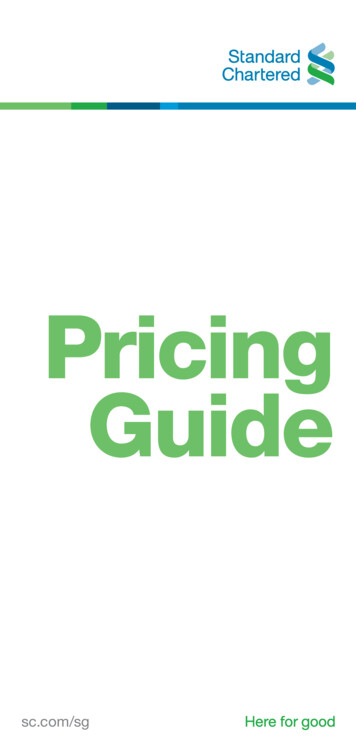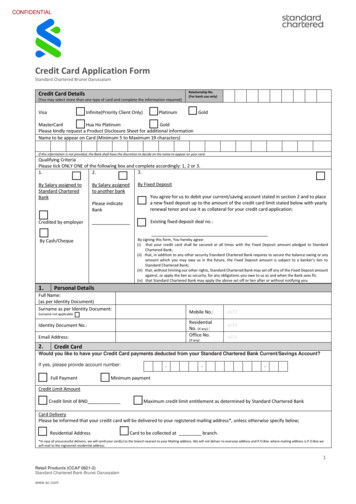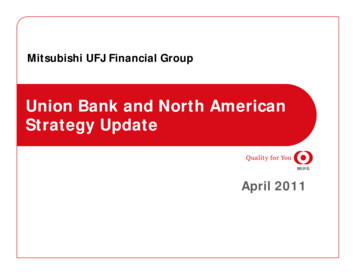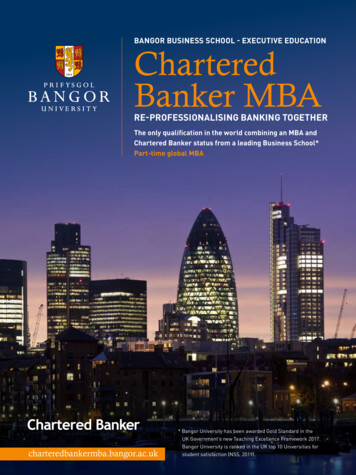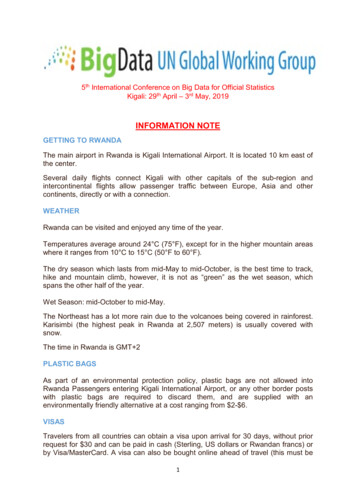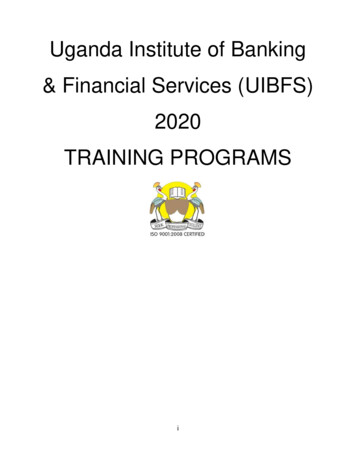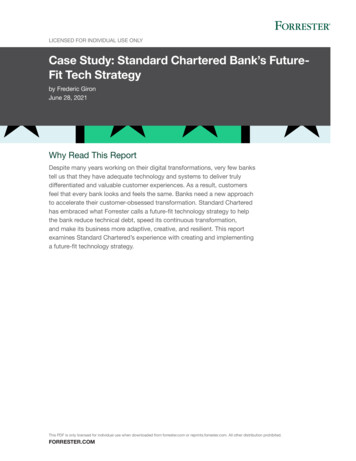
Transcription
LICENSED FOR INDIVIDUAL USE ONLYCase Study: Standard Chartered Bank’s FutureFit Tech Strategyby Frederic GironJune 28, 2021Why Read This ReportDespite many years working on their digital transformations, very few bankstell us that they have adequate technology and systems to deliver trulydifferentiated and valuable customer experiences. As a result, customersfeel that every bank looks and feels the same. Banks need a new approachto accelerate their customer-obsessed transformation. Standard Charteredhas embraced what Forrester calls a future-fit technology strategy to helpthe bank reduce technical debt, speed its continuous transformation,and make its business more adaptive, creative, and resilient. This reportexamines Standard Chartered’s experience with creating and implementinga future-fit technology strategy.This PDF is only licensed for individual use when downloaded from forrester.com or reprints.forrester.com. All other distribution prohibited.FORRESTER.COM
FOR CIOSCase Study: Standard Chartered Bank’s Future-Fit Tech Strategyby Frederic Gironwith Matthew Guarini, Nancy Lin, and Bill NagelJune 28, 2021Vision: Standard Chartered Accelerates Toward Customer ObsessionStandard Chartered (SC) has been around for 160 years, with a significant footprint in Africa, theMiddle East, and Asia and a strong heritage as one of the largest trade banks in the world. Followinga period of chronically weak performance, SC appointed a new group CEO, Bill Winters, in 2015. Thatyear, a new management team set an ambitious strategy to transform the bank, accelerate growth,and improve profitability. It recruited Michael Gorriz as group CIO and made him directly responsiblefor driving the transformation of the bank’s technology systems, reporting to the CEO. As Gorriz put it,“Banks need to reinvent how they work, given the exponential speed at which technology is evolving.”The transformation is not about automating and digitizing functions to generate mere cost savings; it’sabout enabling a customer-obsessed bank that is: Customer-led. Standard Chartered’s ambition is to become “a digital bank with a strong humantouch” serving the mass affluent and the go-to bank for corporates. Gorriz told Forrester:“Technology and humanity are two sides of the same coin. For us, what’s most important is toserve clients in the best possible way. The way to deliver the right solutions is to focus on thecustomer segment of one.” Insights-driven. Banks need to swiftly move from data to insights and actions that drive bettercustomer outcomes. According to Gorriz, “We don’t measure success by the amount of data thatwe’re able to harness or the number of apps we’re able to invent, but by the extent to which bigdata helps us gain more insight into the real, human needs and desires of our clients.” Fast. Banks increasingly compete with digital-native firms that can go from idea to marketlaunch in a matter of weeks. Banks like Standard Chartered make speed a core objective for theirtechnology investments, in addition to risk management and efficiency. Gorriz adds, “Currently,we are at roughly 10 weeks on average from the idea being raised until the request moves intoproduction; we’re shooting for six to eight weeks on average.”Forrester Research, Inc., 60 Acorn Park Drive, Cambridge, MA 02140 USA 1 617-613-6000 Fax: 1 617-613-5000 forrester.com 2021 Forrester Research, Inc. Opinions reflect judgment at the time and are subject to change. Forrester ,Technographics , Forrester Wave, TechRadar, and Total Economic Impact are trademarks of ForresterResearch, Inc. All other trademarks are the property of their respective companies. Unauthorized copying ordistributing is a violation of copyright law. Citations@forrester.com or 1 866-367-7378
FOR DOCROLEJune 28, 2021Case Study: Standard Chartered Bank’s Future-Fit Tech Strategy Connected. An open architecture is paramount for the bank to serve the current and future needsof its customers. According to Gorriz, “Open banking is about putting more choices in the handsof clients. They can decide what data they want to share, increasing their options for suitableservices or products and how they are delivered. From the bank’s perspective, this also opensmany opportunities, because we can now offer banking services through other platforms which arealready integrated in our clients’ lives, whether it’s social media or e-commerce.”Strategy: A Future-Fit Tech Strategy Drives Customer ObsessionFor the first two years of the transformation, Standard Chartered’s technology organization was busystrengthening and upgrading its global systems to preserve their capabilities across its 46 markets.With that objective reached, Gorriz and his team earned the trust and credibility of their business peersto advance a new, ambitious tech strategy that aligns with the core tenets of a future-fit technologystrategy. Companies using this strategy grow revenue at nearly three times the rate of their peers.Forrester defines a future-fit technology strategy as:A customer-obsessed approach to technology that enables a company to quickly reconfigurebusiness structures and capabilities to meet future customer and employee needs with adaptivity,creativity, and resilience.SC wants to be a digital banking leader, not a fast follower. As Gorriz says, “We’re in the middle of amassive transformation to become a digital bank. We can’t wait to see what others are doing; we grabopportunities and use them to transform ourselves.” In 2015, the bank spent about 650 million a yearon technology, 90% of which was defensive, including regulatory compliance. Today, SC devotes morethan half of its 1.6 billion in annual technology spending to strategic and digital enhancements in corebanking, payment systems, and the digital front end across its retail and wholesale business units. Thegoal of this strategy is to make the bank more: Adaptive. Adaptivity is IT’s most important asset, but most companies struggle to respond tochanging conditions due to technical debt, cultural resistance, organizational silos, or resourcingconstraints. Becoming adaptive enables SC to quickly reconfigure its business capabilities tocapture future customer demands and create new growth opportunities like winning a new digitalonly bank license in Hong Kong or creating the nexus banking-as-a-service platform, whichprovides banking services to customers in Indonesia via digital platforms like Bukalapak. Creative. The technology organization needs to deliver an environment that fosters creativity byembracing innovation management principles and treating employee productivity as sacrosanct.In 2018, the bank created SC Ventures as part of Gorriz’s organization to lead digital innovationacross the group, invest in fintechs, and promote the rapid testing and implementation of newbusiness models. SC also focuses on improving employee productivity by using new ways ofworking, such as DevOps and flex work. 2021 Forrester Research, Inc. Unauthorized copying or distributing is a violation of copyright law.Citations@forrester.com or 1 866-367-73782
FOR DOCROLEJune 28, 2021Case Study: Standard Chartered Bank’s Future-Fit Tech Strategy Resilient. In highly regulated industries, baking resilience into the technology strategy is a nobrainer. SC operates in more than 60 countries and interfaces with at least as many regulatorson topics like data sovereignty, reporting frequency, or the use of public cloud; an effective andefficient approach to business resiliency and risk management are core tech topics, a situationexacerbated by COVID-19. “The pandemic shone a spotlight on the need for businesses and banksto be resilient from the risk mitigation, cost, and security perspectives,” said Bhupendra Warathe,chief technology officer for cloud transformation at Standard Chartered. Future-fit firms go evenfurther and consider resilience to be a competitive advantage.Execution: Leverage Platforms, Practices, And PartnersExecution requires bold, courageous leadership — and sometimes supporting contrarian views. Gorrizencouraged his team to experiment, test new approaches, and make up their own minds, insteadof waiting for others to validate the approach. He also encouraged them to take bold steps, likeprioritizing business-critical systems as prime candidates for a migration to public cloud, predictingthat “if core systems go to the cloud, everyone will go to the cloud.” Success earned Gorriz significanttrust within the firm, one of the most important steps in executing a future-fit technology strategy.Cloud platforms, new ways of working, and co-innovation partners are key dimensions of SC’stransformation plan.Standard Chartered’s Platforms Reduce Risk And Accelerate Time-To-ValueAs a critical pillar of the bank’s future-fit technology strategy, Standard Chartered plans to useplatforms to accelerate its transformation, drive co-innovation with partners, and leverage the flexibilityof cloud to deliver more resilient services. Platforms help the bank: Adapt its cloud footprint to local regulations. SC operates in a highly fragmented regulatoryenvironment. Regulators impose a lot of additional scrutiny and oversight requirements when itcomes to public cloud. A hybrid cloud platform enables SC to develop applications on platformas a service and deploy them in accordance with a country’s regulations, using a private clouddeployment as a stopgap until new, more conducive public cloud regulations emerge. As Gorriztold us, “Some regulators are much more open to banks experimenting with new technologiesand business models. In other countries, you can’t, or have to be a little bit more conservative. Sotypically, our innovations are built in a modular way so we can deploy them everywhere or restricttheir deployment to certain countries.” Nineteen countries have approved SC’s use of cloud forcritical workloads; several others have said the bank can migrate less critical systems such as HRto the cloud. By the end of 2020, the bank had 26 major systems in the cloud. Leverage existing business capabilities and drive business innovation. Creative thinking droveSC Ventures, the bank’s innovation, fintech investment, and ventures unit, to build an integrationlayer in the cloud connecting the bank’s core systems (and leveraging its banking license) in 2021 Forrester Research, Inc. Unauthorized copying or distributing is a violation of copyright law.Citations@forrester.com or 1 866-367-73783
FOR DOCROLEJune 28, 2021Case Study: Standard Chartered Bank’s Future-Fit Tech StrategyIndonesia to digital platforms like Bukalapak. Nexus, the resulting cloud-based banking-asa-service platform, allows the bank to distribute its financial services products to Bukalapak’se-commerce clients while respecting Indonesia’s data sovereignty requirements. As nexus was builtfor scale on Amazon Web Services (AWS), it can quickly add large numbers of new customers andpartners. Cloud also enables the bank to easily export successful innovations. As Gorriz told us,“New apps can be piloted in one market and scaled up rapidly across others, which is especiallyimportant for a bank with a footprint as diverse as ours.” Modernize and boost the performance of existing business capabilities. SC’s highlyheterogeneous geographic footprint means that it cannot rely on commercial products for itspayment system. The bank’s award-winning SCPay global payments system was one of the firstsystems it migrated to the cloud. SCPay is now fully cloud-native and handles both high-valuetransactions and micropayments for the e-commerce world. As a result of the migration to AWSand the ability to scale vertically, the payment system’s performance went from 150 transactionsper second to more than 2,500. Solve the age-old problem of standardization vs. localization. Adaptive organizations customizeand differentiate digital customer experiences with thin layers of technology built on platforms’managed APIs or microservices abstraction layers via low-code tools and app marketplaces.“We have good market share in a couple of markets, which means we’ve had the luxury from thebeginning to have global systems for most of our functions. Putting APIs around them gave us apresentation layer that’s independent of our core,” explained Gorriz. SC is able to roll out featuresrapidly to new countries, such as its recent setup of digital-only retail banks in nine African markets.As Gorriz put it, “We built a new ‘skin’ — but because the core is 90% identical, we were able toroll out this ‘skin’ within 15 months.” Drive business resilience and mitigate geopolitical risks. Gorriz sees cloud as a “resilienceoption” to spread risk between the cloud and running on-premises in data centers in London andHong Kong. Given current geopolitical tensions, the bank must hedge its bets. Cloud is the bestway to protect against political uncertainty, as it gives SC the ability to move from one region toanother if necessary — as opposed to having a physical data center that takes years to move.“By accessing the cloud from anywhere, as and when required, we are less dependent on thelocation of data centers and can utilize processing power more flexibly and efficiently. We alsominimize obsolescence, or technical debt, making us leaner and more resilient over the long term,”according to Gorriz.Standard Chartered’s Practices Align Teams To Customer And Business OutcomesStandard Chartered puts significant emphasis on reskilling the business and technology teams. Newways of working are driving new behaviors and a more customer-obsessed culture that emphasizesthe development of core values. New practices combined with platforms and partners also enable thebank to deliver continuous innovation much faster. SC’s future-fit technology practices focus on: 2021 Forrester Research, Inc. Unauthorized copying or distributing is a violation of copyright law.Citations@forrester.com or 1 866-367-73784
FOR DOCROLEJune 28, 2021Case Study: Standard Chartered Bank’s Future-Fit Tech Strategy Driving tech investments with business value. How do you get business execs to supporttechnology investments? By clearly articulating the business outcomes realized during priorexperiments. As Gorriz says, “In India, we are now onboarding in real time, cutting the process froma couple of days to a couple of minutes. We can bring customers into the bank much more quicklythan before, freeing up time to offer our customers better service.” Such outcomes drive theinterest of business stakeholders. When SC started on its cloud-first transformation, the financingprimarily came from the tech team’s investment budget. The experimentation phase was followedby six months of socializing the early results and getting buy-in from teams across technologyand the business. Now, the tech team has substantial investments from SC’s retail and wholesalebusinesses to drive cloud adoption across the bank. Accelerating change while promoting compliance. Traditional bank processes are optimizedfor compliance, not speed. Before a new app can go live, hundreds of security controls need tobe mapped, evidenced, and audited. Pre-transformation, SC’s risk management processes weredesigned for one or two waterfall releases a year. So although tech teams were moving to agile,operational processes were still waterfall, causing frictions and frustration. SC addressed this bysimplifying internal processes to make it easier for colleagues to solve problems and innovate. Toaccelerate change while remaining compliant, the tech team drives the adoption of a DevSecOpspipeline and site reliability engineering tools that embed policy in the platform as code. Thisensures that developers can access self-service innovation capabilities while the platform enforcesthe discipline required to stay compliant. The tech team also sees this as a key lever to change theculture and boost engineering capability across SC. Scaling agile across business and tech teams. Adaptive firms organize permanent, crossfunctional teams around specific customer or business outcomes. Over the past two years, SC hasbeen scaling agile practices across business and technology; now, nearly 1,000 squads supportcorporate and retail banking client journeys, work in new ways, and solve processes from front toback, enabled by business scorecards, quality problem reports, material quality reports, refinementforums, and big room planning. Squads are organized as tribes with common client goals: dayto-day banking, personal loans and credit cards, onboarding, data and client engagement, andopen banking. As Gorriz describes it: “The transformation is run under a fixed capacity model;investment budget is unlocked every quarter based on a tribe’s progress against the plannedand upcoming backlog.” This model enables the bank to keep costs in check while retaining theflexibility to adapt to changing market needs. Driving employee productivity for resilience and employee engagement. During the worstof the pandemic in 2020, SC’s security and regulatory practices and policies enabled the bankto scale from 5,000 remote workers to 80,000 in a matter of weeks. The tech team also had tooverhaul its service management practices, as papers could not be exchanged. So it digitizedand automated the manual, paper-based, change request processes almost overnight, whichdramatically drove the adoption of the DevSecOps Vx Pipeline. Team productivity went through theroof — pushing the bank to ensure that employees pursue an appropriate work/life balance. 2021 Forrester Research, Inc. Unauthorized copying or distributing is a violation of copyright law.Citations@forrester.com or 1 866-367-73785
FOR DOCROLEJune 28, 2021Case Study: Standard Chartered Bank’s Future-Fit Tech Strategy Making the bank’s values and flexible work policies differentiators. The bank’s description onjob portals reads: “To us, good performance is about much more than turning a profit. It’s aboutshowing how you embody our valued behaviors — do the right thing, better together and neversettle — as well as our brand promise, Here for good.” And: “We’d also love to support you inthe way you want to work, be it on a part-time or other flexible work basis.” SC also enacts itsvalues in some of the emerging tech policies it’s developing. For instance, it has been a core partof developing the FEAT (fairness, ethics, accountability, and transparency) framework in Singaporeand is embedding these principles in the AI offerings it develops.Standard Chartered’s Partners Help The Bank InnovateThe bank’s future value depends on how quickly and how well it leverages technology to build newplatforms that differentiate experiences, operations, and offerings. SC knows that it can’t do this alone.Gorriz notes that the bank is “working with fintechs, technology firms, and industry partners to explorehow we can use technology to revolutionize banking services for our clients.” To drive co-innovationwith its partners, Standard Chartered: Focuses on its strategic core and partners for the rest. The bank clearly distinguishes betweencapabilities that are strategic and need to be built in house — such as core banking, payment,and digital engagement platforms — and those that are nondifferentiating and can be sourcedvia software as a service or other partnership models. But even for nondifferentiating capabilities,the bank expects its technical and functional platform partners to bring ideas that continuouslyadvance the bank toward specific objectives. SC Ventures recently worked with fintech partnersSynechron and Squirro to create Client Insights, an AI-driven client insights platform that givesfrontline sales curated and actionable insights to unlock new opportunities. Dedicates an open banking tribe to create new customer value via partnerships. The openbanking tribe focuses on leveraging partnerships and open banking APIs to build new clientjourneys. It has specific goals to grow the number of customers via partnerships and scale upa predefined number of proofs of concept and pilots. The tribe has already launched an API toparticipate in the Monetary Authority of Singapore’s SGFinDex initiative, which allows customers toconsolidate account balances from 10 participating banks using their national digital identity. Theopen banking tribe is in advanced discussions with many strategic partners across markets. Measures performance with reliable and transparent KPIs. Traditional partnerships are definedin lengthy contracts encumbered by legal jargon and poorly defined metrics that lead to ineffectiverelationships. With open banking and APIs, SC can agree with a partner on specific technicalKPIs (like the number of API calls) that will serve as leading indicators of whether the partnershipis fulfilling its promise. In some markets, SC lacks sufficient customer data to support its creditonboarding process; using APIs, it can quickly pilot and monitor a partnership with a firm thatbrings the required customer insights. If the metrics are not satisfactory, the bank can rapidlyswitch to another firm. 2021 Forrester Research, Inc. Unauthorized copying or distributing is a violation of copyright law.Citations@forrester.com or 1 866-367-73786
FOR DOCROLEJune 28, 2021Case Study: Standard Chartered Bank’s Future-Fit Tech Strategy Invests in future disruptive business models. As part of the technology group, SC Ventureshas a war chest of 100 million to invest in fintech firms. It also creates new business models asindependent ventures, such as Solv, a B2B marketplace for small and medium-size businesses inIndia that takes a technology-driven innovation approach to solving problems of alternative creditscoring and underwriting, digitizing operations, and improving the efficiency of supply chains.In addition to being innovation beacons, ventures like nexus and Solv also represent potentiallymeaningful income streams for the bank. Aligns values with different types of commercial models. Value alignment means establishinga commercial model that motivates partners to work toward a common purpose: a clearly definedoutcome of a successful transformation. For Mox, its virtual bank in Hong Kong, SC designedan equity partnership with PCCW, HKT, and Trip.com that ensures that all four have a commondesire to make the virtual bank a success. With nexus, SC uses a revenue-sharing partnershipwith Bukalapak in Indonesia for each new customer acquired via the e-commerce platform. Formore traditional contract-based partnerships, the bank assesses its partners’ ability to influencebusiness outcomes. In rare cases, some of the provider’s fees might be put at risk by leveraging asharing model.Results: Standard Chartered Accelerated Customer ObsessionThree years into its transformation, Standard Chartered is making progress toward customerobsession, improving digital acquisition, digital engagement, and customer experience. Unlike ITorganizations that focus on traditional efficiency metrics such as cost, SC’s tech organization alsomeasures the effectiveness of its strategy with customer and business outcomes. While the executionof the future-fit technology strategy is still in the early stages, early results are promising; the bank has: Boosted digital acquisition and engagement. Modern platforms, value-aligned partners, andproduct teams laser-focused on improving customer and business outcomes helped SC boostperformance in its digital channels. In 2020, 61% of its retail banking clients were digitally active,up from 49% in 2018 and 54% in 2019. The bank’s transformation of its digital engagementplatforms caused digital onboarding to skyrocket from about 30% in 2019 to 80% in 2020; digitalservice also soared, from 25% in 2019 to 70% in 2020; and 68% of its retail product sales weredigital in 2020. COVID-19 provided a major tailwind, but the fact that digital sales are now morethan four times higher than just three years ago is still impressive. Accelerated customer and business value delivery. A future-fit technology strategy enablesspeed and scale. In 2019, it took teams 17 weeks from prioritizing a feature to getting it live. Today,this lead time has fallen to 10 weeks on average across SC’s lines of business. And the benefitsare not limited to tech teams: In one of the markets where the bank rolled out insight-drivenclient engagement capabilities, the marketing team cut the time to conceive, create, and execute 2021 Forrester Research, Inc. Unauthorized copying or distributing is a violation of copyright law.Citations@forrester.com or 1 866-367-73787
FOR DOCROLEJune 28, 2021Case Study: Standard Chartered Bank’s Future-Fit Tech Strategycampaigns on pre-login channels by 80%. Mox, one of the fastest-growing banks in Hong Konghistory, went from initial licensing to market deployment in 18 months; SC built Mox on a digitalonly platform using Thought Machine for its core banking systems, running on AWS. Improved customer experiences. Forrester has shown that the quality perceived by customersas they interact with a firm’s physical or digital touchpoints is a good predictor of the ability todrive loyalty and revenue growth. Over the past couple of years, SC has recorded a significantimprovement in its Net Promoter ScoreSM (NPS), a strong indication that the bank is moving in theright (customer-obsessed) direction. For instance, from 2019 to 2020, the NPS of mobile bankingincreased in seven out of nine markets; the average increase was 10 points. The bank is also ratedbest in class in China, India, and Malaysia. Drove employee engagement and productivity. Over a 12-month period, the bank recorded ahuge increase in digital ways of working: 164 million virtual digital collaboration minutes, 153 millionchat sessions, 27 million voice conversations, 9.5 million desktops connected to virtual meetings,and 1.4 million mobile devices connected to virtual meetings. Despite this massive growth, thenumber of IT issues raised by employees fell by 25% and a key collaboration tool was provisioned70% faster — so employees benefited from capabilities quicker. The employee experience forend user services (IT support for employees) was positive, with an average NPS of 33, averagecustomer satisfaction of 81%, and an average customer effort score of 76%. 2021 Forrester Research, Inc. Unauthorized copying or distributing is a violation of copyright law.Citations@forrester.com or 1 866-367-73788
FOR DOCROLEJune 28, 2021Case Study: Standard Chartered Bank’s Future-Fit Tech StrategyEngage With An AnalystGain greater confidence in your decisions by working with Forrester thought leaders to applyour research to your specific business and technology initiatives.Analyst InquiryAnalyst AdvisoryWebinarTo help you put researchinto practice, connectwith an analyst to discussyour questions in a30-minute phone session— or opt for a responsevia email.Translate research intoaction by working withan analyst on a specificengagement in the formof custom strategysessions, workshops,or speeches.Join our online sessionson the latest researchaffecting your business.Each call includes analystQ&A and slides and isavailable on-demand.Learn more.Learn more.Learn more.Forrester’s research apps for iOS and Android.Stay ahead of your competition no matter where you are.Supplemental MaterialResearch MethodologiesNet Promoter and NPS are registered service marks, and Net Promoter Score is a service mark, of Bain& Company, Inc., Satmetrix Systems, Inc., and Fred Reichheld.Companies We Interviewed For This ReportWe would like to thank the individuals from the following companies who generously gave their timeduring the research for this report.AWSStandard Chartered Bank 2021 Forrester Research, Inc. Unauthorized copying or distributing is a violation of copyright law.Citations@forrester.com or 1 866-367-73789
forrester.comWe help business and technology leaders usecustomer obsession to accelerate growth.PRODUCTS AND SERVICES›››››››Research and toolsAnalyst engagementData and analyticsPeer collaborationConsultingEventsCertification programsForrester’s research and insights are tailored to yourrole and critical business initiatives.ROLES WE SERVEMarketing & StrategyProfessionalsCMOB2B MarketingB2C MarketingCustomer ExperienceCustomer InsightseBusiness & ChannelStrategyTechnology ManagementProfessionals CIOApplication Development& DeliveryEnterprise ArchitectureInfrastructure & OperationsSecurity & RiskSourcing & VendorManagementTechnology IndustryProfessionalsAnalyst RelationsCLIENT SUPPORTFor information on hard-copy or electronic reprints, please contact Client Support at 1 866-367-7378, 1 617-613-5730, or clientsupport@forrester.com. We offer quantitydiscounts and special pricing for academic and nonprofit institutions.166080
banking, payment systems, and the digital front end across its retail and wholesale business units. The goal of this strategy is to make the bank more: Adaptive. Adaptivity is IT's most important asset, but most companies struggle to respond to changing conditions due to technical debt, cultural resistance, organizational silos, or resourcing




